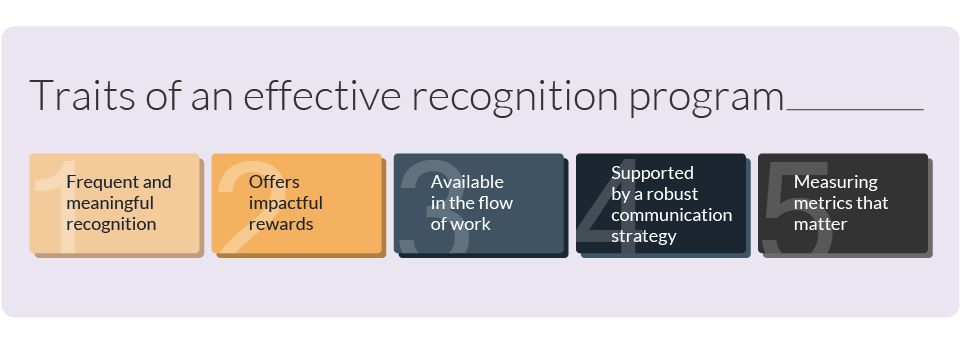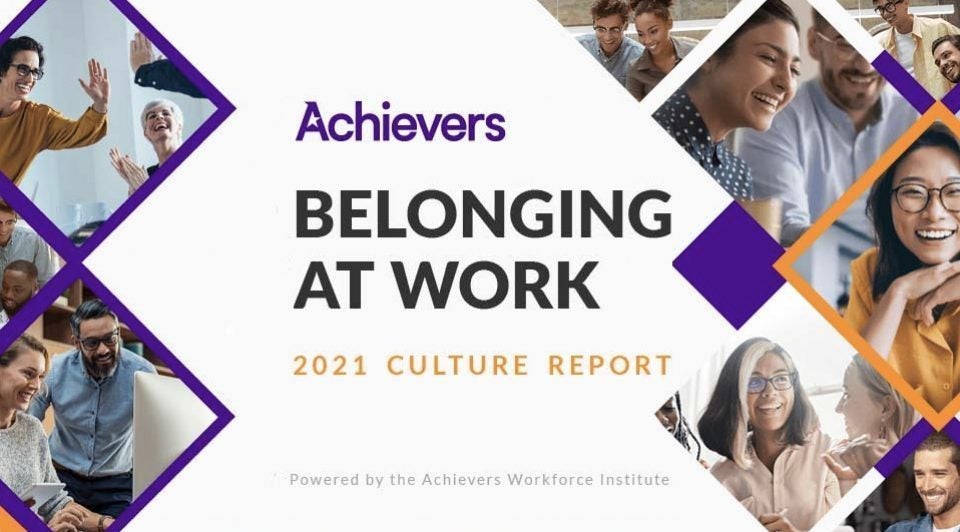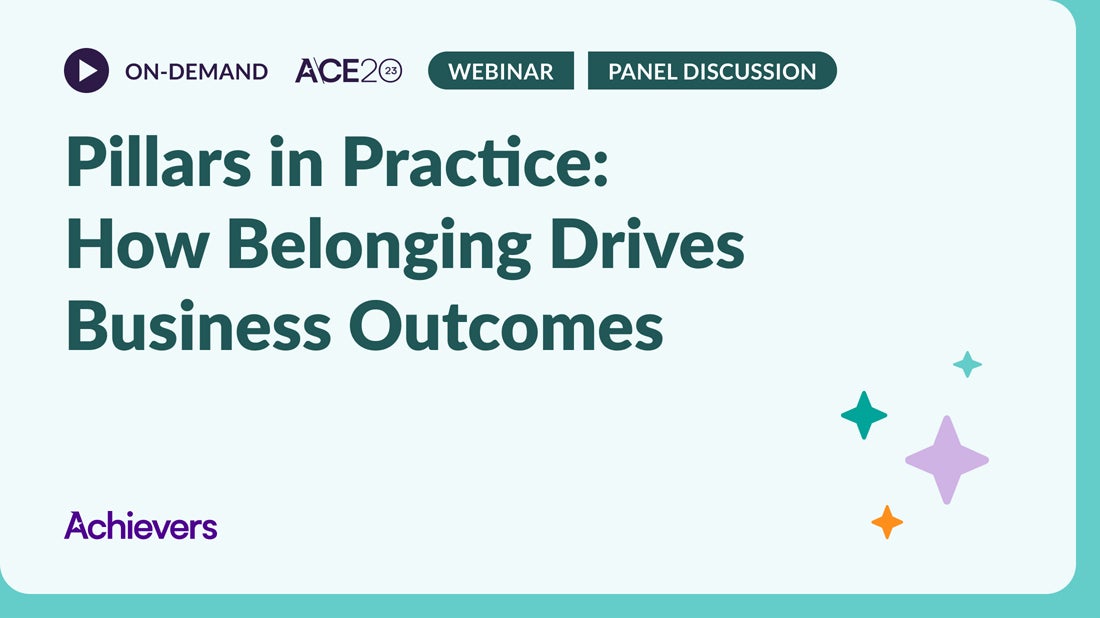Table of contents
Belonging at work is the ultimate measure of employee happiness and effectiveness, but it can also sound tenuous and difficult to pin down. The Achievers Workforce Institute Belonging Blueprint makes belonging measurable and actionable so business leaders can make a bigger impact on their employees’ wellbeing and their organization’s success.
What is belonging?
The Achievers Workforce Institute (AWI) defines belonging as an experience of connection, security, and community — it’s about feeling at home in one’s place, without reservation.
We know from AWI and other research that people who feel a strong sense of belonging at work are more likely to have high employee engagement. In fact, a strong sense of belonging correlates positively with job satisfaction, mental health, and productivity. And it correlates negatively with fatigue and emotional exhaustion. When business leaders invest in belonging at work, they will see higher performance and lower burnout.
What are the five pillars of belonging?
The five pillars of belonging have been developed with academic research and test with primary and business research. When any one pillar is activated, the rate of belonging doubles. When all five are activated, the rate of belonging triples.
The pillars are:
Welcomed: Introduced to, and incorporated within, the organizational culture and community
Known: Understood, motivated, and celebrated as an individual
Included: Valued and accepted without reservation
Supported: Consistently and meaningfully nurtured and developed
Connected: Developing and maintaining relationships across a diverse population
How to measure belonging at work
Measure belonging at work by including belonging questions in your regular employee surveys. AWI recommends six questions for your employee survey: one for belonging in general, and one for each of the five pillars of belonging:
- Overall sense of belonging: I feel a strong sense of belonging at my organization
- Welcomed: I feel warmly welcomed at my company (first day, new team, new role)
- Known: I feel known as an individual at my company
- Included: I feel included at work (can be myself, my opinions are valued, can respectfully disagree)
- Supported: I am supported at work in achieving my personal and professional development goals
- Connected: I feel a strong connection with peers and colleagues
Examples are included when we want to prompt people to think about specific scenarios. An employee who has worked at a company for more than three years may not remember how day one felt but prompting them to think about joining a new team or moving into a new role will help expand their definition of being welcomed.
How often should I ask belonging questions?
Ask belonging questions at least once a year. When running pulse surveys (three or more surveys a year), you might choose to cycle through different questions to keep the total length shorter. In that case, include the overall belonging metric every time, with the pillar questions asked at least once a year so you can see where any changes have had impact.
If belonging is a new metric at your organization, you might choose to do an ad hoc survey about belonging to get a baseline, rather than including it in your next scheduled engagement survey.
What drives belonging at work?
Many things influence belonging at work. AWI has identified six key factors to increase belonging and activate the belonging pillars. These lsix factors are compensation and benefits, recognition, feedback, relationships at work, manager effectiveness, and culture alignment.
Compensation and benefits
While compensation is not the biggest belonging driver, it is a crucial foundation. People who say their salary is fair and competitive are 35% more likely to also feel a strong sense of belonging. When employees believe they are not being paid fairly, they will feel undervalued and are less likely to trust their manager and senior leaders.
The number-one benefit to drive belonging is unlimited vacation. Employees who said their company offered this benefit were 43% more likely to say they feel a strong sense of belonging at the company.
Recognition
Frequent, meaningful recognition is one of the biggest drivers of belonging. Employees who say they feel meaningfully recognized at work are more than twice as likely to have a strong sense of belonging. AWI recommends aiming for at least monthly recognition for every employee — employees who receive this recognition frequency are more likely to feel recognized in general and have higher rates of belonging.
In addition, employees with the right recognition platform are 55% more likely to feel a strong sense of belonging and are 85% more likely to feel meaningfully recognized at work. The traits of an effective recognition platform include supporting frequent and meaningful recognition. Look for a platform that can drive at least monthly recognition for employees, in a combination of social and monetary recognitions. Other features to look for are a comprehensive reward marketplace, an excellent mobile app, integrations that support flow-of-work recognition, and turnkey resources for running campaigns to increase usage and impact.
Research shows that there are five traits of an effective recognition program:

- Frequent and meaningful recognition
Employees should be recognized at least monthly. This recognition can be monetary or social, but must be meaningful: specific, personal, and impact-oriented. - Offers impactful rewards
Personalized rewards have the biggest impact. Supported by points that can be spent on a wide range of redemption options from gift cards to physical merchandise. - Available in the flow of work
Solutions should include a consumer-grade mobile app and integrate with programs employees use daily. On the admin side, HRIS integration is a must. - Supported by a robust communication strategy
From launch to ongoing maintenance, a consistent communication plan is key to achieving high usage and effective recognition. - Measuring metrics that matter
With HRIS integration, it’s possible to move beyond pure usage data to look at correlations between recognition frequency and engagement or turnover.
Feedback
Gathering and acting on feedback supports a culture of belonging. Employees who say their company does at least three surveys a year are 44% more likely to feel a strong sense of belonging compared to those whose companies run one or less surveys a year. Adding feedback tools such as ad hoc surveys and always-on listening tools such as chatbots increases belonging again — companies with pulse engagement surveys, ad hoc feedback, and always-on listening have almost double the rate of belonging compared to average.
Companies must take action on feedback to see the true impact on belonging. When employees say their company is excellent at taking action on feedback, they are almost three times more likely to have a strong sense of belonging. It’s not enough to ask the right questions, HR and business leaders must be seen to be responding and taking action.
Relationships
Having friends at work is one of the biggest predictors of satisfaction and retention. Employees who say their company supports them in building relationships at work are 2.4 times more likely to say they have a strong sense of belonging.
Enabling employees to connect and build relationships is crucial for creating strong teams and organizational networks. Employees rate connection tools as the technology that would most help them feel a stronger sense of belonging at work. In addition, employees who report their organization offers connection tools are 34% more likely to say they feel a strong sense of belonging at work.
Manager effectiveness
People with an effective manager are 76% more likely to feel a strong sense of belonging compared to average and are almost six times more likely to feel this sense of belonging than those with an ineffective manager.
AWI measures effectiveness with the manager net promoter score (mNPS), which correlates strongly with every belonging pillar. The difference between an effective and ineffective manager is staggering, especially for the support pillar. Employees who give their manager a high mNPS score are more than 10 times more likely to say they feel supported at work compared to those with a low mNPS score.
Culture alignment
Organizations with strong culture alignment — those where communication, recognition, and prioritization are all made with company values in mind — have higher rates of belonging, lower turnover, and better resilience. In turbulent times, employees that believe their company leaders can be trusted to walk their talk are less uncertain and apprehensive, which increases their engagement and belonging.
What is the first step to a culture of belonging at work?
The first step to building a culture of belonging is to assess where you are today and identify the biggest opportunities for improvement. Ask the belonging questions in your next survey and look at which pillar has the most potential for immediate action and improvement. AWI recommends focusing on one pillar at a time to avoid spreading yourself too thin and to have meaningful impact for frontline employees.
Ready to learn more about belonging at work? Get the AWI Belonging Blueprint today for the ultimate guide to belonging at work based on more than four years of academic, business, and customer research.




